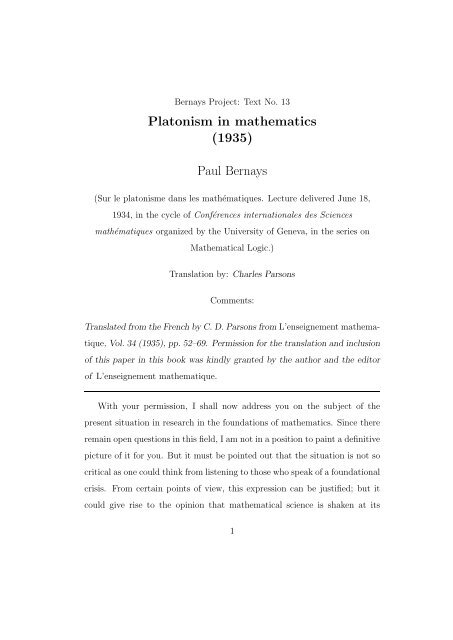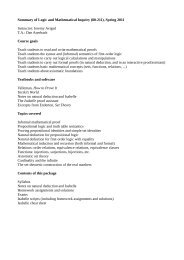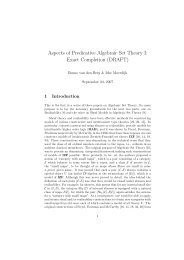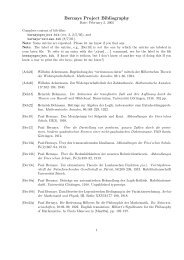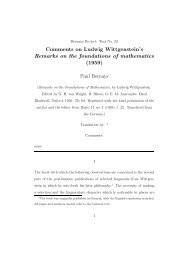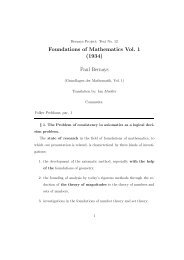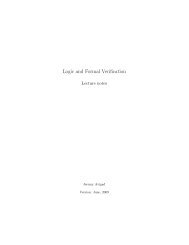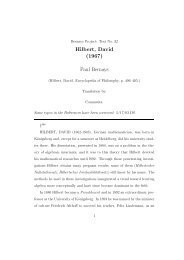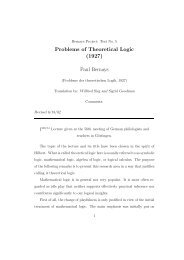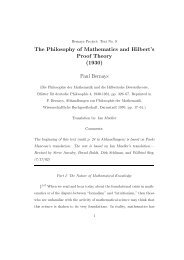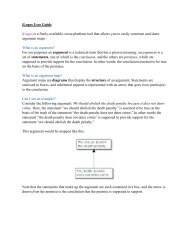Platonism in mathematics (1935) Paul Bernays - Phil Cmu
Platonism in mathematics (1935) Paul Bernays - Phil Cmu
Platonism in mathematics (1935) Paul Bernays - Phil Cmu
Create successful ePaper yourself
Turn your PDF publications into a flip-book with our unique Google optimized e-Paper software.
<strong>Bernays</strong> Project: Text No. 13<br />
<strong>Platonism</strong> <strong>in</strong> <strong>mathematics</strong><br />
(<strong>1935</strong>)<br />
<strong>Paul</strong> <strong>Bernays</strong><br />
(Sur le platonisme dans les mathématiques. Lecture delivered June 18,<br />
1934, <strong>in</strong> the cycle of Conférences <strong>in</strong>ternationales des Sciences<br />
mathématiques organized by the University of Geneva, <strong>in</strong> the series on<br />
Mathematical Logic.)<br />
Translation by: Charles Parsons<br />
Comments:<br />
Translated from the French by C. D. Parsons from L’enseignement mathema-<br />
tique, Vol. 34 (<strong>1935</strong>), pp. 52–69. Permission for the translation and <strong>in</strong>clusion<br />
of this paper <strong>in</strong> this book was k<strong>in</strong>dly granted by the author and the editor<br />
of L’enseignement mathematique.<br />
With your permission, I shall now address you on the subject of the<br />
present situation <strong>in</strong> research <strong>in</strong> the foundations of <strong>mathematics</strong>. S<strong>in</strong>ce there<br />
rema<strong>in</strong> open questions <strong>in</strong> this field, I am not <strong>in</strong> a position to pa<strong>in</strong>t a def<strong>in</strong>itive<br />
picture of it for you. But it must be po<strong>in</strong>ted out that the situation is not so<br />
critical as one could th<strong>in</strong>k from listen<strong>in</strong>g to those who speak of a foundational<br />
crisis. From certa<strong>in</strong> po<strong>in</strong>ts of view, this expression can be justified; but it<br />
could give rise to the op<strong>in</strong>ion that mathematical science is shaken at its<br />
1
oots. The truth is that the mathematical sciences are grow<strong>in</strong>g <strong>in</strong> complete<br />
security and harmony. The ideas of Dedek<strong>in</strong>d, Po<strong>in</strong>caré, and Hilbert have<br />
been systematically developed with great success, without any conflict <strong>in</strong> the<br />
results. It is only from the philosophical po<strong>in</strong>t of view that objections have<br />
been raised. They bear on certa<strong>in</strong> ways of reason<strong>in</strong>g peculiar to analysis and<br />
set theory. These modes of reason<strong>in</strong>g were first systematically applied <strong>in</strong><br />
giv<strong>in</strong>g a rigorous form to the methods of the calculus. [Accord<strong>in</strong>g to them,]<br />
the objects of a theory are viewed as elements of a totality such that one<br />
can reason as follows: For each property expressible us<strong>in</strong>g the notions of the<br />
theory, it is [an] objectively determ<strong>in</strong>ate [fact] whether there is or there is not<br />
an element of the totality which possesses this property. Similarly, it follows<br />
from this po<strong>in</strong>t of view that either all the elements of a set possess a given<br />
property, or there is at least one element which does not possess it.<br />
An example of this way of sett<strong>in</strong>g up a theory can be found <strong>in</strong> Hilbert’s ax-<br />
iomatization of geometry. If we compare Hilbert’s axiom system to Euclid’s,<br />
ignor<strong>in</strong>g the fact that the Greek geometer fails to <strong>in</strong>clude certa<strong>in</strong> [necessary]<br />
postulates, we notice that Euclid speaks of figures to be constructed 1 whereas,<br />
for Hilbert, system of po<strong>in</strong>ts, straight l<strong>in</strong>es, and planes exist from the outset.<br />
Euclid postulates: One can jo<strong>in</strong> two po<strong>in</strong>ts by a straight l<strong>in</strong>e; Hilbert states<br />
the axiom: Given any two po<strong>in</strong>ts, there exists a straight l<strong>in</strong>e on which both<br />
are situated. “Exists” refers here to existence <strong>in</strong> the system of straight l<strong>in</strong>es.<br />
This example shows already that the tendency of which we are speak<strong>in</strong>g<br />
consists <strong>in</strong> view<strong>in</strong>g the objects as cut off from all l<strong>in</strong>ks with the reflect<strong>in</strong>g<br />
subject.<br />
1 [Translator’s italics.]<br />
2
S<strong>in</strong>ce this tendency asserted itself especially <strong>in</strong> the philosophy of Plato,<br />
allow me to call it “platonism.”<br />
The value of platonistically <strong>in</strong>spired mathematical conceptions is that<br />
they furnish models of abstract imag<strong>in</strong>ation. These stand out by their sim-<br />
plicity and logical strength. They form representations which extrapolate<br />
from certa<strong>in</strong> regions of experience and <strong>in</strong>tuition.<br />
Nonetheless, we know that we can arithmetize the theoretical systems<br />
of geometry and physics. For this reason, we shall direct our attention to<br />
platonism <strong>in</strong> arithmetic. But I am referr<strong>in</strong>g to arithmetic <strong>in</strong> a very broad<br />
sense, which <strong>in</strong>cludes analysis and set theory.<br />
The weakest of the “platonistic” assumptions <strong>in</strong>troduced by arithmetic is<br />
that of the totality of <strong>in</strong>tegers. The tertium non datum for <strong>in</strong>tegers follows<br />
from it; viz.: if P is a predicate of <strong>in</strong>tegers, either P is true of each number,<br />
or there is at least one exception.<br />
By the assumption mentioned, this disjunction is an immediate conse-<br />
quence of the logical pr<strong>in</strong>ciple of the excluded middle; <strong>in</strong> analysis it is almost<br />
cont<strong>in</strong>ually applied.<br />
For example, it is by means of it that one concludes that for two real<br />
numbers a and b, given by convergent series, either a = b or a < b or b < a;<br />
and likewise: a sequence of positive rational numbers either comes as close<br />
as you please to zero or there is a positive rational number less than all the<br />
members of the sequence.<br />
At first sight, such disjunctions seem trivial, and we must be attentive<br />
<strong>in</strong> order to notice that an assumption slips <strong>in</strong>. But analysis is not content<br />
with this modest variety of platonism; it reflects it to a stronger degree<br />
3
with respect to the follow<strong>in</strong>g notions: set of numbers, sequence of numbers,<br />
and function. It abstracts from the possibility of giv<strong>in</strong>g def<strong>in</strong>itions of sets,<br />
sequences, and functions. These notions are used <strong>in</strong> a “quasi-comb<strong>in</strong>atorial”<br />
sense, by which I mean: <strong>in</strong> the sense of an analogy of the <strong>in</strong>f<strong>in</strong>ite to the f<strong>in</strong>ite.<br />
Consider, for example, the different functions which assign to each mem-<br />
ber of the f<strong>in</strong>ite series 1, 2, . . . , n a number of the same series. There are n n<br />
functions of this sort, and each of them is obta<strong>in</strong>ed by n <strong>in</strong>dependent de-<br />
term<strong>in</strong>ations. Pass<strong>in</strong>g to the <strong>in</strong>f<strong>in</strong>ite case, we imag<strong>in</strong>e functions engendered<br />
by an <strong>in</strong>f<strong>in</strong>ity of <strong>in</strong>dependent determ<strong>in</strong>ations which assign to each <strong>in</strong>teger an<br />
<strong>in</strong>teger, and we reason about the totality of these functions.<br />
In the same way, one views a set of <strong>in</strong>tegers as the result of <strong>in</strong>f<strong>in</strong>itely<br />
many <strong>in</strong>dependent acts decid<strong>in</strong>g for each number whether it should be <strong>in</strong>-<br />
cluded or excluded. We add to this the idea of the totality of these sets.<br />
Sequences of real numbers and sets of real numbers are envisaged <strong>in</strong> an anal-<br />
ogous manner. From this po<strong>in</strong>t of view, constructive def<strong>in</strong>itions of specific<br />
functions, sequences, and sets arc only ways to pick out an object which<br />
exists <strong>in</strong>dependently of, and prior to, the construction.<br />
The axiom of choice is an immediate application of the quasi-comb<strong>in</strong>atorial<br />
concepts <strong>in</strong> question. It is generally employed <strong>in</strong> the theory of real numbers<br />
<strong>in</strong> the follow<strong>in</strong>g special form. Let<br />
M1, M2 . . .<br />
be a sequence of non-empty sets of real numbers, then there is a sequence<br />
a1, a2 . . .<br />
. such that for every <strong>in</strong>dex n, an is an element of Mn.<br />
4
The pr<strong>in</strong>ciple becomes subject to objections if the effective construction<br />
of the sequence of numbers is demanded.<br />
A similar case is that of Po<strong>in</strong>caré’s impredicative def<strong>in</strong>itions. An impred-<br />
icative def<strong>in</strong>ition of a real number appeals to the hypothesis that all real<br />
numbers have a certa<strong>in</strong> property P , or the hypothesis that there exists a real<br />
number with the property T .<br />
This k<strong>in</strong>d of def<strong>in</strong>ition depends on the assumption of [the existence of]<br />
the totality of sequences of <strong>in</strong>tegers, because a real number is represented by<br />
a decimal fraction, that is to say, by a special k<strong>in</strong>d of sequence of <strong>in</strong>tegers.<br />
It is used <strong>in</strong> particular to prove the fundamental theorem that a bounded<br />
set of real numbers always has a least upper bound.<br />
In Cantor’s theories, platonistic conceptions extend far beyond those of<br />
the theory of real numbers. This is done by iterat<strong>in</strong>g the use of the quasi-<br />
comb<strong>in</strong>atorial concept of a function and add<strong>in</strong>g methods of collection. This<br />
is the well-known method of set theory.<br />
The platonistic conceptions of analysis and set theory have also been<br />
applied <strong>in</strong> modern theories of algebra and topology, where they have proved<br />
very fertile.<br />
This brief summary will suffice to characterize platonism and its appli-<br />
cation to <strong>mathematics</strong>. This application is so widespread that it is not an<br />
exaggeration to say that platonism reigns today <strong>in</strong> <strong>mathematics</strong>.<br />
But on the other hand, we see that this tendency has been criticized <strong>in</strong><br />
pr<strong>in</strong>ciple s<strong>in</strong>ce its first appearance and has given rise to many discussions.<br />
This criticism was re<strong>in</strong>forced by the paradoxes discovered <strong>in</strong> set theory, even<br />
though these ant<strong>in</strong>omies refute only extreme platonism.<br />
5
We have set forth only a restricted platonism which does not claim to<br />
be more than, so to speak, an ideal projection of a doma<strong>in</strong> of thought. But<br />
the matter has not rested there. Several mathematicians and philosophers<br />
<strong>in</strong>terpret the methods of platonism <strong>in</strong> the sense of conceptual realism, pos-<br />
tulat<strong>in</strong>g the existence of a world of ideal objects conta<strong>in</strong><strong>in</strong>g all the objects<br />
and relations of <strong>mathematics</strong>. It is this absolute platonism which has been<br />
shown untenable by the ant<strong>in</strong>omies, particularly by those surround<strong>in</strong>g the<br />
Russell-Zermelo paradox.<br />
If one hears them for the first time, these paradoxes <strong>in</strong> their purely logical<br />
form can seem to be plays on words without serious significance. Nonetheless<br />
one must consider that these abbreviated forms of the paradoxes are obta<strong>in</strong>ed<br />
by follow<strong>in</strong>g out the consequences of the various requirements of absolute<br />
platonism.<br />
The essential importance of these ant<strong>in</strong>omies is to br<strong>in</strong>g out the impos-<br />
sibility of comb<strong>in</strong><strong>in</strong>g the follow<strong>in</strong>g two th<strong>in</strong>gs: the idea of the totality of all<br />
mathematical objects and the general concepts of set and function; for the<br />
totality itself would form a doma<strong>in</strong> of elements for sets, and arguments and<br />
values for functions. We must therefore give up absolute platonism. But it<br />
must be observed that this is almost the only <strong>in</strong>junction which follows from<br />
the paradoxes. Some will th<strong>in</strong>k that this is regrettable, s<strong>in</strong>ce the paradoxes<br />
are appealed to on every side. But avoid<strong>in</strong>g the paradoxes does not consti-<br />
tute a univocal program. In particular, restricted platonism is not touched<br />
at all by the ant<strong>in</strong>omies.<br />
Still, the critique of the foundations of analysis receives new impetus<br />
from this source, and among the different possible ways of escap<strong>in</strong>g from the<br />
6
paradoxes, elim<strong>in</strong>at<strong>in</strong>g platonism offered itself as the most radical.<br />
Let us look and see how this elim<strong>in</strong>ation can be brought about. It is done<br />
<strong>in</strong> two steps, correspond<strong>in</strong>g to the two essential assumptions <strong>in</strong>troduced by<br />
platonism. The first step is to replace by constructive concepts the concepts<br />
of a set, a sequence, or a function, which I have called quasi-comb<strong>in</strong>atorial.<br />
The idea of an <strong>in</strong>f<strong>in</strong>ity of <strong>in</strong>dependent determ<strong>in</strong>ations is rejected. One em-<br />
phasizes that an <strong>in</strong>f<strong>in</strong>ite sequence or a decimal fraction can be given only<br />
by an arithmetical law, and one regards the cont<strong>in</strong>uum as a set of elements<br />
def<strong>in</strong>ed by such laws.<br />
This procedure is adapted to the tendency toward a complete arithmeti-<br />
zation of analysis. Indeed, it must be conceded that the arithmetization of<br />
analysis is not carried through to the end by the usual method. The concep-<br />
tions which are applied there are not completely reducible, as we have seen,<br />
to the notion of <strong>in</strong>teger and logical concepts.<br />
Nonetheless, if we pursue the thought that each real number is def<strong>in</strong>ed<br />
by an arithmetical law, the idea of the totality of real numbers is no longer<br />
<strong>in</strong>dispensable, and the axiom of choice is not at all evident. Also, unless we<br />
<strong>in</strong>troduce auxiliary assumptions—as Russell and Whitehead do—we must do<br />
without various usual conclusions. Weyl has made these consequences very<br />
clear <strong>in</strong> his book Das Kont<strong>in</strong>uum.<br />
Let us proceed to the second step of the elim<strong>in</strong>ation. It consists <strong>in</strong> re-<br />
nounc<strong>in</strong>g the idea of the totality of <strong>in</strong>tegers. This po<strong>in</strong>t of view was first<br />
defended by Kronecker and then developed systematically by Brouwer.<br />
Although several of you heard <strong>in</strong> March [1934] an authentic exposition of<br />
this method by Professor Brouwer himself, I shall allow myself a few words<br />
7
of explanation.<br />
A misunderstand<strong>in</strong>g about Kronecker must first be dissipated, which<br />
could arise from his often-cited aphorism that the <strong>in</strong>tegers were created by<br />
God, whereas everyth<strong>in</strong>g else <strong>in</strong> <strong>mathematics</strong> is the work of man. If that were<br />
really Kronecker’s op<strong>in</strong>ion, he ought to admit the concept of the totality of<br />
<strong>in</strong>tegers.<br />
In fact, Kronecker’s method, as well as that of Brouwer, is characterized<br />
by the fact that it avoids the supposition that there exists a series of natural<br />
numbers form<strong>in</strong>g a determ<strong>in</strong>ate ideal object.<br />
Accord<strong>in</strong>g to Kronecker and Brouwer, one can speak of the series of num-<br />
bers only <strong>in</strong> the sense of a process that is never f<strong>in</strong>ished, surpass<strong>in</strong>g each<br />
limit which it reaches.<br />
This po<strong>in</strong>t of departure carries with it the other divergences, <strong>in</strong> particular<br />
those concern<strong>in</strong>g the application and <strong>in</strong>terpretation of logical forms: Neither<br />
a general judgment about <strong>in</strong>tegers nor a judgment of existence can be <strong>in</strong>ter-<br />
preted as express<strong>in</strong>g a property of the series of numbers. A general theorem<br />
about numbers is to be regarded as a sort of prediction that a property will<br />
present itself for each construction of a number; and the affirmation of the<br />
existence of a number with a certa<strong>in</strong> property is <strong>in</strong>terpreted as an <strong>in</strong>complete<br />
communication of a more precise proposition <strong>in</strong>dicat<strong>in</strong>g a [particular] number<br />
hav<strong>in</strong>g the property <strong>in</strong> question or a method for obta<strong>in</strong><strong>in</strong>g such a number;<br />
Hilbert calls it a “partial judgment.”<br />
For the same reasons the negation of a general or existential proposition<br />
about <strong>in</strong>tegers does not have precise sense. One must strengthen the nega-<br />
tion to arrive at a mathematical proposition. For example, it is to give a<br />
8
strengthened negation of a proposition affirm<strong>in</strong>g the existence of a number<br />
with a property P to say that a number with the property P cannot be given,<br />
or further, that the assumption of a number with this property leads to a<br />
contradiction. But for such strengthened negations the law of the excluded<br />
middle is no longer applicable.<br />
The characteristic complications to be met with <strong>in</strong> Brouwer’s “<strong>in</strong>tuition-<br />
istic” method come from this.<br />
For example, one may not generally make use of disjunctions like these:<br />
a series of positive terms is either convergent or divergent; two convergent<br />
sums represent either the same real number or different ones.<br />
In the theory of <strong>in</strong>tegers and of algebraic numbers, we can avoid these<br />
difficulties and manage to preserve all the essential theorems and arguments.<br />
In fact, Kronecker has already shown that the core of the theory of alge-<br />
braic fields can be developed from his methodological po<strong>in</strong>t of view without<br />
appeal to the totality of <strong>in</strong>tegers. 2<br />
As for analysis, you know that Brouwer has developed it <strong>in</strong> accord with<br />
the requirements of <strong>in</strong>tuitionism. But here one must abandon a number of the<br />
usual theorems, for example, the fundamental theorem that every cont<strong>in</strong>uous<br />
2 To this end, Kronecker set forth <strong>in</strong> his lectures a manner of <strong>in</strong>troduc<strong>in</strong>g the notion of<br />
algebraic number which has been almost totally forgotten, although it is the most elemen-<br />
tary way of def<strong>in</strong><strong>in</strong>g this notion. This method consists <strong>in</strong> represent<strong>in</strong>g algebraic numbers<br />
by the changes of sign of irreducible polynomials <strong>in</strong> one variable with rational <strong>in</strong>tegers as<br />
coefficients; start<strong>in</strong>g from that def<strong>in</strong>ition, one <strong>in</strong>troduces the elementary operations and<br />
relations of magnitude for algebraic numbers and proves that the ord<strong>in</strong>ary laws of calcu-<br />
lation hold; f<strong>in</strong>ally one shows that a polynomial with algebraic coefficients hav<strong>in</strong>g values<br />
with different signs for two algebraic arguments a and b has a zero between a and b.<br />
9
function has a maximum <strong>in</strong> a closed <strong>in</strong>terval. Very few th<strong>in</strong>gs <strong>in</strong> set theory<br />
rema<strong>in</strong> valid <strong>in</strong> <strong>in</strong>tuitionist <strong>mathematics</strong>.<br />
We would say, roughly, that <strong>in</strong>tuitionism is adapted to the theory of<br />
numbers; the semiplatonistic method, which makes use of the idea of the<br />
totality of <strong>in</strong>tegers but avoids quasi-comb<strong>in</strong>atorial concepts, is adapted to<br />
the arithmetic theory of functions, and the usual platonism is adequate for<br />
the geometric theory of the cont<strong>in</strong>uum.<br />
There is noth<strong>in</strong>g astonish<strong>in</strong>g about this situation, for it is a familiar proce-<br />
dure of the contemporary mathematician to restrict his assumptions <strong>in</strong> each<br />
doma<strong>in</strong> of the science to those which are essential. By this restriction, a the-<br />
ory ga<strong>in</strong>s methodological clarity, and it is <strong>in</strong> this direction that <strong>in</strong>tuitionism<br />
proves fruitful.<br />
But as you know, <strong>in</strong>tuitionism is not at all content with such a role; it<br />
opposes the usual <strong>mathematics</strong> and claims to represent the only true math-<br />
ematics.<br />
On the other hand, mathematicians generally are not at all ready to ex-<br />
change the well-tested and elegant methods of analysis for more complicated<br />
methods unless there is an overrid<strong>in</strong>g necessity for it.<br />
We must discuss the question more deeply. Let us try to portray more<br />
dist<strong>in</strong>ctly the assumptions and philosophic character of the <strong>in</strong>tuitionistic<br />
method.<br />
What Brouwer appeals to is evidence. He claims that the basic ideas<br />
of <strong>in</strong>tuitionism are given to us <strong>in</strong> an evident manner by pure <strong>in</strong>tuition. In<br />
rely<strong>in</strong>g on this, he reveals his partial agreement with Kant. But whereas for<br />
Kant there exists a pure <strong>in</strong>tuition with respect to space and time, Brouwer<br />
10
acknowledges only the <strong>in</strong>tuition of time, from which, like Kant, he derives<br />
the <strong>in</strong>tuition of number.<br />
As for this philosophic position, it seems to me that one must concede<br />
to Brouwer two essential po<strong>in</strong>ts: first, that the concept of <strong>in</strong>teger is of <strong>in</strong>-<br />
tuitive orig<strong>in</strong>. In this respect noth<strong>in</strong>g is changed by the <strong>in</strong>vestigations of<br />
the logicists, 3 to which I shall return later. Second, one ought not to make<br />
arithmetic and geometry correspond <strong>in</strong> the manner <strong>in</strong> which Kant did. The<br />
concept of number is more elementary than the concepts of geometry.<br />
Still it seems a bit hasty to deny completely the existence of a geometrical<br />
<strong>in</strong>tuition. But let us leave that question aside here; there are other, more<br />
urgent ones. Is it really certa<strong>in</strong> that the evidence given by arithmetical<br />
<strong>in</strong>tuition extends exactly as far as the boundaries of <strong>in</strong>tuitionist arithmetic<br />
would require? And f<strong>in</strong>ally: Is it possible to draw an exact boundary between<br />
what is evident and what is only plausible?<br />
I believe that one must answer these two questions negatively. To beg<strong>in</strong><br />
with, you know that men and even scholars do not agree about evidence<br />
<strong>in</strong> general. Also, the same man sometimes rejects suppositions which he<br />
previously regarded as evident.<br />
An example of a much-discussed question of evidence, about which there<br />
has been controversy up to the present, is that of the axiom of parallels. I<br />
th<strong>in</strong>k that the criticism which has been directed aga<strong>in</strong>st that axiom is partly<br />
expla<strong>in</strong>ed by the special place which it has <strong>in</strong> Euclid’s system. Various other<br />
axioms had been omitted, so that the parallels axiom stood out from the<br />
others by its complexity.<br />
3 [I have rendered ’logiciens’ throughout as ’logicists’.—Trans.]<br />
11
In this matter I shall be content to po<strong>in</strong>t out the follow<strong>in</strong>g: One can<br />
have doubts concern<strong>in</strong>g the evidence of geometry, hold<strong>in</strong>g that it extends<br />
only to topological facts or to the facts expressed by the projective axioms.<br />
One can, on the other hand, claim that geometric <strong>in</strong>tuition is not exact.<br />
These op<strong>in</strong>ions. are self-consistent, and all have arguments <strong>in</strong> their favor.<br />
But to claim that metric geometry has an evidence restricted to the laws<br />
common to Euclidean and Bolyai-Lobachevskian geometry, an exact metrical<br />
evidence which yet would not guarantee the existence of a perfect square,<br />
seems to me rather artificial. And yet it was the po<strong>in</strong>t of view of a number<br />
of mathematicians.<br />
Our concern here has been to underl<strong>in</strong>e the difficulties to be encountered<br />
<strong>in</strong> try<strong>in</strong>g to describe the limits of evidence.<br />
Nevertheless, these difficulties do not make it impossible that there should<br />
be anyth<strong>in</strong>g evident beyond question, and certa<strong>in</strong>ly <strong>in</strong>tuitionism offers some<br />
such. But does it conf<strong>in</strong>e itself completely with<strong>in</strong> the region of this elementary<br />
evidence? This is not completely <strong>in</strong>dubitable, for the follow<strong>in</strong>g reason: Intu-<br />
itionism makes no allowance for the possibility that, for very large numbers,<br />
the operations required by the recursive method of construct<strong>in</strong>g numbers can<br />
cease to have a concrete mean<strong>in</strong>g. From two <strong>in</strong>tegers k, l one passes immedi-<br />
ately to k l ; this process leads <strong>in</strong> a few steps to numbers which are far larger<br />
than any occurr<strong>in</strong>g <strong>in</strong> experience, e.g., 67 (257729 ) ).<br />
Intuitionism, like ord<strong>in</strong>ary <strong>mathematics</strong>, claims that this number can be<br />
represented by an Arabic numeral. Could not one press further the criticism<br />
which <strong>in</strong>tuitionism makes of existential assertions and raise the question:<br />
What does it mean to claim the existence of an Arabic numeral for the<br />
12
forego<strong>in</strong>g number, s<strong>in</strong>ce <strong>in</strong> practice we are not <strong>in</strong> a position to obta<strong>in</strong> it?<br />
Brouwer appeals to <strong>in</strong>tuition, but one can doubt that the evidence for it<br />
really is <strong>in</strong>tuitive. Isn’t this rather an application of the general method of<br />
analogy, consist<strong>in</strong>g <strong>in</strong> extend<strong>in</strong>g to <strong>in</strong>accessible numbers the relations which<br />
we can concretely verify for accessible numbers? As a matter of fact, the<br />
reason for apply<strong>in</strong>g this analogy is strengthened by the fact that there is no<br />
precise boundary between the numbers which are accessible and those which<br />
are not. One could <strong>in</strong>troduce the notion of a “practicable” procedure, and<br />
implicitly restrict the import of recursive def<strong>in</strong>itions to practicable opera-<br />
tions. To avoid contradictions, it would suffice to absta<strong>in</strong> from apply<strong>in</strong>g the<br />
pr<strong>in</strong>ciple of the excluded middle to the notion of practicability. But such<br />
abstention goes without say<strong>in</strong>g for <strong>in</strong>tuitionism.<br />
I hope I shall not be misunderstood: I am far from recommend<strong>in</strong>g that<br />
arithmetic be done with this restriction. I am concerned only to show that<br />
<strong>in</strong>tuitionism takes as its basis propositions which one can doubt and <strong>in</strong> pr<strong>in</strong>-<br />
ciple do without, although the result<strong>in</strong>g theory would be rather meager.<br />
It is therefore not absolutely <strong>in</strong>dubitable that the doma<strong>in</strong> of complete<br />
evidence extends to all of <strong>in</strong>tuitionism. On the other hand, several math-<br />
ematicians recognize the complete evidence of <strong>in</strong>tuitionistic arithmetic and<br />
moreover ma<strong>in</strong>ta<strong>in</strong> that the concept of the series of numbers is evident <strong>in</strong><br />
the follow<strong>in</strong>g sense: The affirmation of the existence of a number does not<br />
require that one must, directly or recursively, give a bound for this number.<br />
Besides, we have just seen how far beyond a really concrete presentation such<br />
a limitation would be.<br />
In short, the po<strong>in</strong>t of view of <strong>in</strong>tuitive evidence does not decide uniquely<br />
13
<strong>in</strong> favor of <strong>in</strong>tuitionism.<br />
In addition, one must observe that the evidence which <strong>in</strong>tuitionism uses <strong>in</strong><br />
its arguments is not always of an immediate character. Abstract reflections<br />
are also <strong>in</strong>cluded. In fact, <strong>in</strong>tuitionists often use statements, conta<strong>in</strong><strong>in</strong>g a<br />
general hypothesis, of the form ‘if every number n has the property A(n),<br />
then B holds’.<br />
Such a statement is <strong>in</strong>terpreted <strong>in</strong>tuitionistically <strong>in</strong> the follow<strong>in</strong>g manner:<br />
‘If it is proved that every number n possesses the property A(n), then B.’<br />
Here we have a hypothesis of an abstract k<strong>in</strong>d, because s<strong>in</strong>ce the methods of<br />
demonstration are not fixed <strong>in</strong> <strong>in</strong>tuitionism, the condition that someth<strong>in</strong>g is<br />
proved is not <strong>in</strong>tuitively determ<strong>in</strong>ed.<br />
It is true that one can also <strong>in</strong>terpret the given statement by view<strong>in</strong>g it<br />
as a partial judgment, i.e., as the claim that there exists a proof of B from<br />
the given hypothesis, a proof which would be effectively given. 4 (This is<br />
approximately the sense of Kolmogorov’s <strong>in</strong>terpretation of <strong>in</strong>tuitionism.) In<br />
any case, the argument must start from the general hypothesis, which cannot<br />
be <strong>in</strong>tuitively fixed. It is therefore an abstract reflection.<br />
In the example just considered, the abstract part is rather limited. The<br />
abstract character becomes more pronounced if one superposes hypotheses;<br />
i.e., when one formulates propositions like the follow<strong>in</strong>g: ‘if from the hypoth-<br />
esis that A(n) is valid for every n, one can <strong>in</strong>fer B, then C holds’, or ‘If from<br />
the hypothesis that A leads to a contradiction, a contradiction follows, then<br />
B’, or briefly ‘If the absurdity of A is absurd, then B’. This abstractness of<br />
4 [“. . . c’est à dire comme une <strong>in</strong>dication d’un raisonnement conduisant de la dite hy-<br />
pothèse à la conclusion B, raisonnement qu’on présente effectivement.”]<br />
14
statements can be still further <strong>in</strong>creased.<br />
It is by the systematic application of these forms of abstract reason<strong>in</strong>g<br />
that Brouwer has gone beyond Kronecker’s methods and succeeded <strong>in</strong> estab-<br />
lish<strong>in</strong>g a general <strong>in</strong>tuitionistic logic, which has been systematized by Heyt<strong>in</strong>g.<br />
If we consider this <strong>in</strong>tuitionistic logic, <strong>in</strong> which the notions of consequence<br />
are applied without reservation, and we compare the method used here with<br />
the usual one, we notice that the characteristic general feature of <strong>in</strong>tuitionism<br />
is not that of be<strong>in</strong>g founded on pure <strong>in</strong>tuition, but rather [that of be<strong>in</strong>g<br />
founded] on the relation of the reflect<strong>in</strong>g and act<strong>in</strong>g subject to the whole<br />
development of science.<br />
This is an extreme methodological position. It is contrary to the cus-<br />
tomary manner of do<strong>in</strong>g <strong>mathematics</strong>, which consists <strong>in</strong> establish<strong>in</strong>g theories<br />
detached as much as possible from the th<strong>in</strong>k<strong>in</strong>g subject.<br />
This realization leads us to doubt that <strong>in</strong>tuitionism is the sole legitimate<br />
method of mathematical reason<strong>in</strong>g. For even if we admit that the tendency<br />
away from the [th<strong>in</strong>k<strong>in</strong>g] subject has been pressed too far under the reign of<br />
platonism, this does not lead us to believe that the truth lies <strong>in</strong> the opposite<br />
extreme. Keep<strong>in</strong>g both possibilities <strong>in</strong> m<strong>in</strong>d, we shall rather aim to br<strong>in</strong>g<br />
about <strong>in</strong> each branch of science, an adaptation of method to the character<br />
of the object <strong>in</strong>vestigated.<br />
For example, for number theory the use of the <strong>in</strong>tuitive concept of a<br />
number is the most natural. In fact, one can thus establish the theory of<br />
numbers without <strong>in</strong>troduc<strong>in</strong>g an axiom, such as that of complete <strong>in</strong>duction,<br />
or axioms of <strong>in</strong>f<strong>in</strong>ity like those of Dedek<strong>in</strong>d and Russell.<br />
Moreover, <strong>in</strong> order to avoid the <strong>in</strong>tuitive concept of number, one is led to<br />
15
<strong>in</strong>troduce a more general concept, like that of a proposition, a function, or<br />
an arbitrary correspondence, concepts which are <strong>in</strong> general not objectively<br />
def<strong>in</strong>ed. It is true that such a concept can be made more def<strong>in</strong>ite by the<br />
axiomatic method, as <strong>in</strong> axiomatic set theory, but then the system of axioms<br />
is quite complicated.<br />
You know that Frege tried to deduce arithmetic from pure logic by view-<br />
<strong>in</strong>g the latter as the general theory of the universe of mathematical objects.<br />
Although the foundation of this absolutely platonistic enterprise was under-<br />
m<strong>in</strong>ed by the Russell-Zermelo paradox, the school of logicists has not given<br />
up the idea of <strong>in</strong>corporat<strong>in</strong>g arithmetic <strong>in</strong> a system of logic. In place of abso-<br />
lute platonism, they have <strong>in</strong>troduced some <strong>in</strong>itial assumptions. But because<br />
of these, the system loses the character of pure logic.<br />
In the system of Pr<strong>in</strong>cipia Mathematica, it is not only the axioms of <strong>in</strong>f<strong>in</strong>-<br />
ity and reducibility which go beyond pure logic, but also the <strong>in</strong>itial conception<br />
of a universal doma<strong>in</strong> of <strong>in</strong>dividuals and of a doma<strong>in</strong> of predicates. It is re-<br />
ally an ad hoc assumption to suppose that we have before us the universe<br />
of th<strong>in</strong>gs divided <strong>in</strong>to subjects and predicates, ready-made for theoretical<br />
treatment.<br />
But even with such auxiliary assumptions, one cannot successfully <strong>in</strong>cor-<br />
porate the whole of arithmetic <strong>in</strong>to the system of logic. For, s<strong>in</strong>ce this system<br />
is developed accord<strong>in</strong>g to fixed rules, one would have to be able to obta<strong>in</strong> by<br />
means of a fixed series of rules all the theorems of arithmetic. But this is not<br />
the case; as Gödel has shown, arithmetic goes beyond each given formalism.<br />
(In fact, the same is true of axiomatic set theory.)<br />
Besides, the desire to deduce arithmetic from logic derives from the tra-<br />
16
ditional op<strong>in</strong>ion that the relation of logic to arithmetic is that of general<br />
to particular. The truth, it seems to me, is that mathematical abstraction<br />
does not have a lesser degree than logical abstraction, but rather another<br />
direction.<br />
These considerations do not detract at all from the <strong>in</strong>tr<strong>in</strong>sic value of that<br />
research of logicists which aims at develop<strong>in</strong>g logic systematically and formal-<br />
iz<strong>in</strong>g mathematical proofs. We were concerned here only with defend<strong>in</strong>g the<br />
thesis that for the theory of numbers, the <strong>in</strong>tuitive method is more suitable.<br />
On the other hand, for the theory of the cont<strong>in</strong>uum, given by analysis,<br />
the <strong>in</strong>tuitionist method seems rather artificial. The idea of the cont<strong>in</strong>uum is<br />
a geometrical idea which analysis expresses <strong>in</strong> terms of arithmetic.<br />
Is the <strong>in</strong>tuitionist method of represent<strong>in</strong>g the cont<strong>in</strong>uum better adapted<br />
to the idea of the cont<strong>in</strong>uum than the usual one?<br />
Weyl would have us believe this. He reproaches ord<strong>in</strong>ary analysis for de-<br />
compos<strong>in</strong>g the cont<strong>in</strong>uum <strong>in</strong>to s<strong>in</strong>gle po<strong>in</strong>ts. But isn’t this reproach better<br />
addressed to semiplatonism, which views the cont<strong>in</strong>uum as a set of arith-<br />
metical laws? The fact is that for the usual method there is a completely<br />
satisfy<strong>in</strong>g analogy between the manner <strong>in</strong> which a particular po<strong>in</strong>t stands out<br />
from the cont<strong>in</strong>uum and the manner <strong>in</strong> which a real number def<strong>in</strong>ed by an<br />
arithmetical law stands out from the set of all real numbers, whose elements<br />
are <strong>in</strong> general only implicitly <strong>in</strong>volved, by virtue of the quasi-comb<strong>in</strong>atorial<br />
concept of a sequence.<br />
This analogy seems to me to agree better with the nature of the cont<strong>in</strong>uum<br />
than that which <strong>in</strong>tuitionism establishes between the fuzzy character of the<br />
cont<strong>in</strong>uum and the uncerta<strong>in</strong>ties aris<strong>in</strong>g from unsolved arithmetical problems.<br />
17
It is true that <strong>in</strong> the usual analysis the notion of a cont<strong>in</strong>uous function,<br />
and also that of a differentiable function, have a generality go<strong>in</strong>g far beyond<br />
our <strong>in</strong>tuitive representation of a curve. Nevertheless <strong>in</strong> this analysis, we can<br />
establish the theorem of the maximum of a cont<strong>in</strong>uous function and Rolle’s<br />
theorem, thus rejo<strong>in</strong><strong>in</strong>g the <strong>in</strong>tuitive conception.<br />
Intuitionist analysis, even though it beg<strong>in</strong>s with a much more restricted<br />
notion of a function, does not arrive at such simple theorems; they must<br />
<strong>in</strong>stead be replaced by more complex ones. This stems from the fact that on<br />
the <strong>in</strong>tuitionistic conception, the cont<strong>in</strong>uum does not have the character of<br />
a totality, which undeniably belongs to the geometric idea of the cont<strong>in</strong>uum.<br />
And it is this characteristic of the cont<strong>in</strong>uum which would resist perfect<br />
arithmetization.<br />
These considerations lead us to notice that the duality of arithmetic and<br />
geometry is not unrelated to the opposition between <strong>in</strong>tuitionism and platon-<br />
ism. The concept of number appears <strong>in</strong> arithmetic. It is of <strong>in</strong>tuitive orig<strong>in</strong>,<br />
but then the idea of the totality of numbers is superimposed. On the other<br />
hand, <strong>in</strong> geometry the platonistic idea of space is primordial, and it is aga<strong>in</strong>st<br />
this background that the <strong>in</strong>tuitionist procedures of construct<strong>in</strong>g figures take<br />
place.<br />
This suffices to show that the two tendencies, <strong>in</strong>tuitionist and platonist,<br />
are both necessary; they complement each other, and it would be do<strong>in</strong>g<br />
oneself violence to renounce one or the other.<br />
But the duality of these two tendencies, like that of arithmetic and geom-<br />
etry, is not a perfect symmetry. As we have noted, it is not proper to make<br />
arithmetic and geometry correspond completely: the idea of number is more<br />
18
immediate to the m<strong>in</strong>d than the idea of space. Likewise, we must recognize<br />
that the assumptions of platonism have a transcendent character which is<br />
not found <strong>in</strong> <strong>in</strong>tuitionism.<br />
It is also this transcendent character which requires us to take certa<strong>in</strong><br />
precautions <strong>in</strong> regard to each platonistic assumption. For even when such a<br />
supposition is not at all arbitrary and presents itself naturally to the m<strong>in</strong>d, it<br />
can still be that the pr<strong>in</strong>ciple from which it proceeds permits only a restricted<br />
application, outside of which one would fall <strong>in</strong>to contradiction. We must be<br />
all the more careful <strong>in</strong> the face of this possibility, s<strong>in</strong>ce the drive for simplicity<br />
leads us to make our pr<strong>in</strong>ciples as broad as possible. And the need for a<br />
restriction is often not noticed. This was the case, as we have seen, for the<br />
pr<strong>in</strong>ciple of totality, which was pressed too far by absolute platonism. Here<br />
it was only the discovery of the Russell-Zermelo paradox which showed that<br />
a restriction was necessary.<br />
Thus it is desirable to f<strong>in</strong>d a method to make sure that the platonistic<br />
assumptions on which <strong>mathematics</strong> is based do not go beyond permissible<br />
limits. The assumptions <strong>in</strong> question reduce to various forms of the pr<strong>in</strong>ciple<br />
of totality and of the pr<strong>in</strong>ciple of analogy or of the permanence of laws. And<br />
the condition restrict<strong>in</strong>g the application of these pr<strong>in</strong>ciples is none other<br />
than that of the consistency of the consequences which are deduced from the<br />
fundamental assumptions.<br />
As you know, Hilbert is try<strong>in</strong>g to f<strong>in</strong>d ways of giv<strong>in</strong>g us such assurances<br />
of consistency, and his proof theory has this as its goal.<br />
This theory relies <strong>in</strong> part on the results of the logicists. They have shown<br />
that the arguments applied <strong>in</strong> arithmetic, analysis, and set theory can be for-<br />
19
malized. That is, they can be expressed <strong>in</strong> symbols and as symbolic processes<br />
which unfold accord<strong>in</strong>g to fixed rules. To primitive propositions correspond<br />
<strong>in</strong>itial formulae, and to each logical deduction corresponds a sequence of for-<br />
mulae derivable from one another accord<strong>in</strong>g to given rules. In this formalism,<br />
a platonistic assumption is represented by an <strong>in</strong>itial formula or by a rule es-<br />
tablish<strong>in</strong>g a way of pass<strong>in</strong>g from formulae already obta<strong>in</strong>ed to others. In<br />
this way, the <strong>in</strong>vestigation of the possibilities of proof reduces to problems<br />
like those which are found <strong>in</strong> elementary number theory. In particular, the<br />
consistency of the theory will be proved if one succeeds <strong>in</strong> prov<strong>in</strong>g that it is<br />
impossible to deduce two mutually contradictory formulae A and Ā (with the<br />
bar represent<strong>in</strong>g negation). This statement which is to be proved is of the<br />
same structure as that, for example, assert<strong>in</strong>g the impossibility of satisfy<strong>in</strong>g<br />
the equation a 2 = 2b 2 by two <strong>in</strong>tegers a and b.<br />
Thus by symbolic reduction, the question of the consistency of a theory<br />
reduces to a problem of an elementary arithmetical character.<br />
Start<strong>in</strong>g from this fundamental idea, Hilbert has sketched a detailed pro-<br />
gram of a theory of proof, <strong>in</strong>dicat<strong>in</strong>g the lead<strong>in</strong>g ideas of the arguments (for<br />
the ma<strong>in</strong> consistency proofs). His <strong>in</strong>tention was to conf<strong>in</strong>e himself to <strong>in</strong>tuitive<br />
and comb<strong>in</strong>atorial considerations; his “f<strong>in</strong>itary po<strong>in</strong>t of view” was restricted<br />
to these methods.<br />
In this framework, the theory was developed up to a certa<strong>in</strong> po<strong>in</strong>t. Several<br />
mathematicians have contributed to it: Ackermann, von Neumann, Skolem,<br />
Herbrand, Gödel, Gentzen. Nonetheless, these <strong>in</strong>vestigations have rema<strong>in</strong>ed<br />
with<strong>in</strong> a relatively restricted doma<strong>in</strong>. In fact, they did not even reach a proof<br />
of the consistency of the axiomatic theory of <strong>in</strong>tegers. It is known that the<br />
20
symbolic representation of this theory is obta<strong>in</strong>ed by add<strong>in</strong>g to the ord<strong>in</strong>ary<br />
logical calculus formalizations of Peano’s axioms and the recursive def<strong>in</strong>itions<br />
of sum (a + b) and product (a · b).<br />
Light was shed on this situation by a general theorem of Gödel, accord-<br />
<strong>in</strong>g to which a proof of the consistency of a formalized theory cannot be<br />
represented by means of the formalism considered. From this theorem, the<br />
follow<strong>in</strong>g more special proposition follows: It is impossible to prove by ele-<br />
mentary comb<strong>in</strong>atorial methods the consistency of a formalized theory which<br />
can express every elementary comb<strong>in</strong>atorial proof of an arithmetical propo-<br />
sition.<br />
Now it seems that this proposition applies to the formalism of the ax-<br />
iomatic theory of numbers. At least, no attempt made up to now has given<br />
us any example of an elementary comb<strong>in</strong>atorial proof which cannot be ex-<br />
pressed <strong>in</strong> this formalism, and the methods by which one can, <strong>in</strong> the cases<br />
considered, translate a proof <strong>in</strong>to the aforementioned formalism, seem to<br />
suffice <strong>in</strong> general.<br />
Assum<strong>in</strong>g that this is so, 5 we arrive at the conclusion that means more<br />
powerful than elementary comb<strong>in</strong>atorial methods are necessary to prove the<br />
consistency of the axiomatic theory of numbers. A new discovery of Gödel<br />
and Gentzen leads us to such a more powerful method. They have shown<br />
(<strong>in</strong>dependently of one another) that the consistency of <strong>in</strong>tuitionist arithmetic<br />
implies the consistency of the axiomatic theory of numbers. This result<br />
5 In try<strong>in</strong>g to demonstrate the possibility of translat<strong>in</strong>g each elementary comb<strong>in</strong>atorial<br />
proof of an arithmetical proposition <strong>in</strong>to the formalism of the axiomatic theory of numbers,<br />
we are confronted with the difficulty of delimit<strong>in</strong>g precisely the doma<strong>in</strong> of elementary<br />
comb<strong>in</strong>atorial methods.<br />
21
was obta<strong>in</strong>ed by us<strong>in</strong>g Heyt<strong>in</strong>g’s formalization of <strong>in</strong>tuitionist arithmetic and<br />
logic. The argument is conducted by elementary methods, <strong>in</strong> a rather simple<br />
manner. In order to conclude from this result that the axiomatic theory of<br />
numbers is consistent, it suffices to assume the consistency of <strong>in</strong>tuitionist<br />
arithmetic.<br />
This proof of the consistency of axiomatic number theory shows us, among<br />
other th<strong>in</strong>gs, that <strong>in</strong>tuitionism, by its abstract arguments, goes essentially<br />
beyond elementary comb<strong>in</strong>atorial methods.<br />
The question which now arises is whether the strengthen<strong>in</strong>g of the method<br />
of proof theory obta<strong>in</strong>ed by admitt<strong>in</strong>g the abstract arguments of <strong>in</strong>tuitionism<br />
would put us <strong>in</strong>to a position to prove the consistency of analysis. The answer<br />
would be very important and even decisive for proof theory, and even, it seems<br />
to me, for the role which is to be attributed to <strong>in</strong>tuitionistic methods.<br />
Research <strong>in</strong> the foundations of <strong>mathematics</strong> is still develop<strong>in</strong>g. Several<br />
basic questions are open, and we do not know what we shall discover <strong>in</strong><br />
this doma<strong>in</strong>. But these <strong>in</strong>vestigations excite our curiosity by their chang<strong>in</strong>g<br />
perspectives, and that is a sentiment which is not aroused to the same degree<br />
by the more classical parts of science, which have atta<strong>in</strong>ed greater perfection.<br />
I wish to thank Professor Wavre, who was k<strong>in</strong>d enough to help me improve<br />
the text of this lecture for publication. I also thank M. Rueff, who was good<br />
enough to look over the first draft to improve the French.<br />
22


